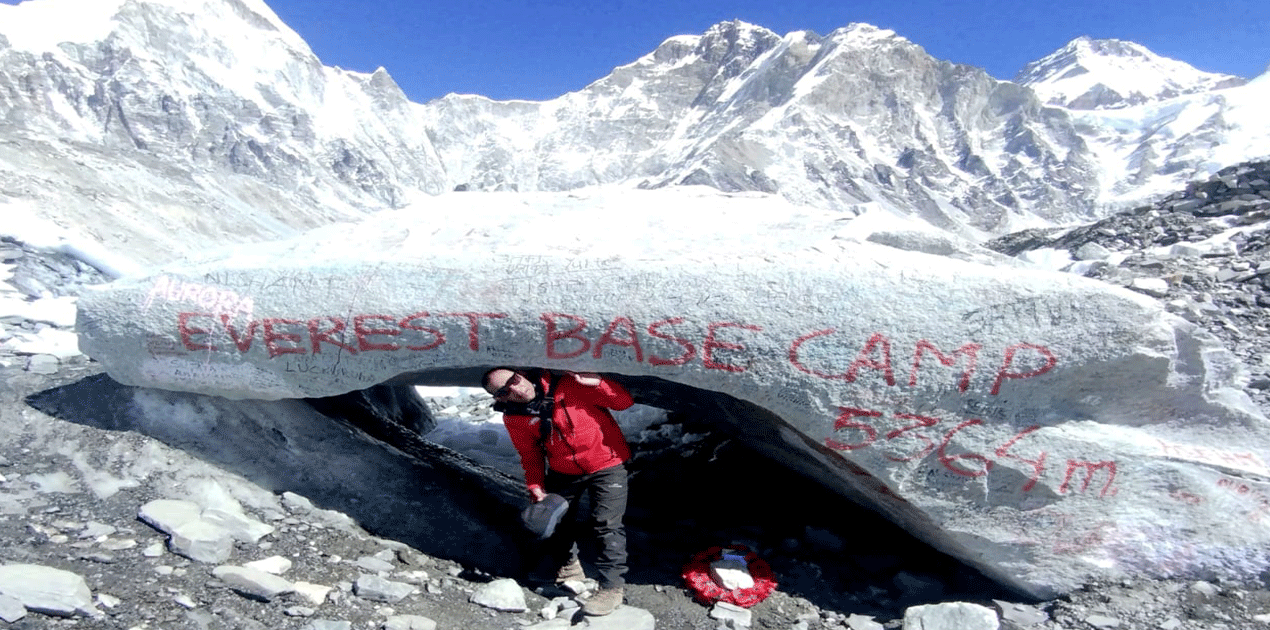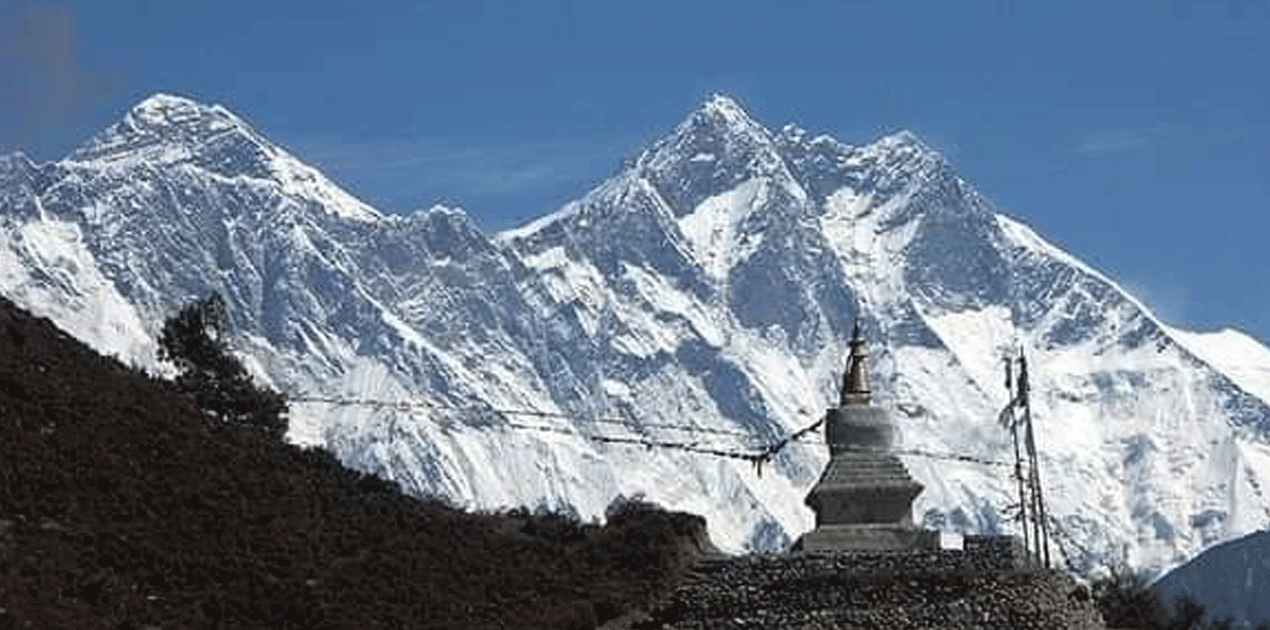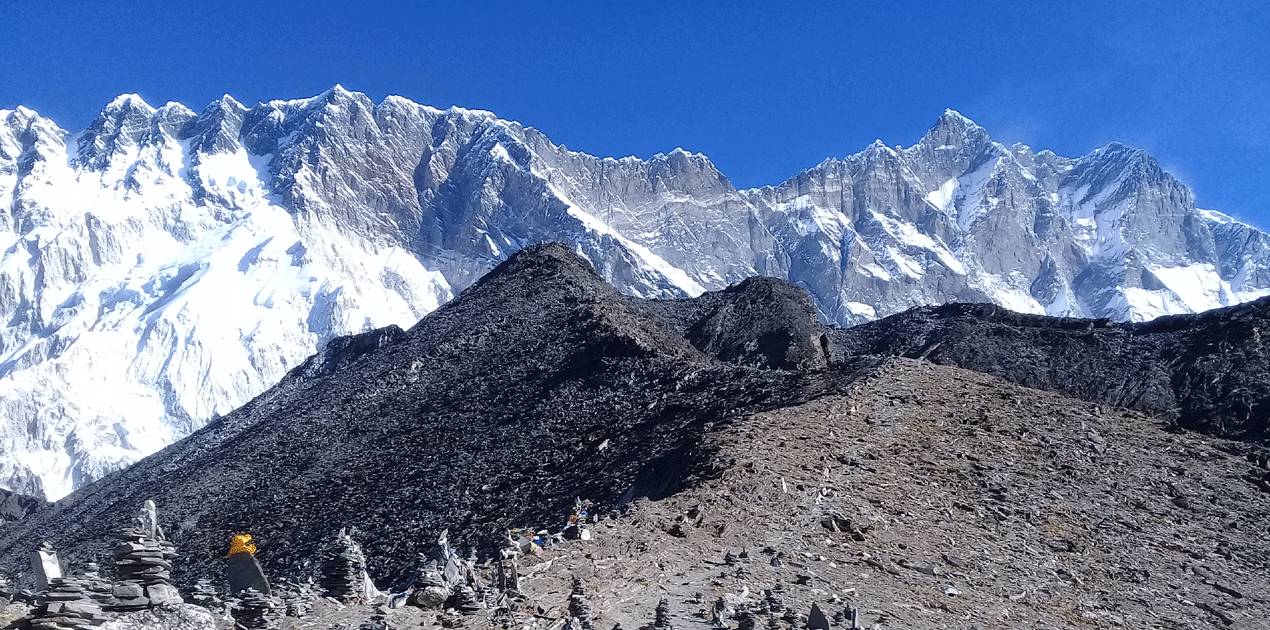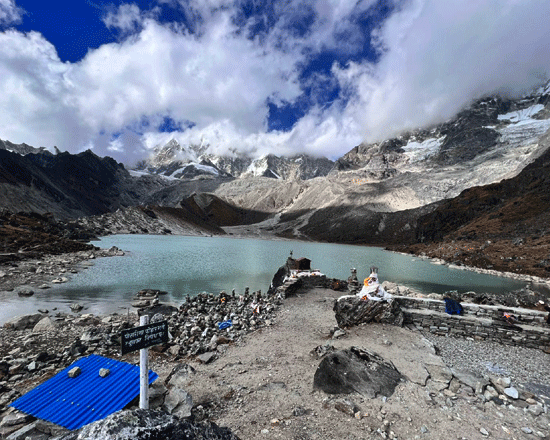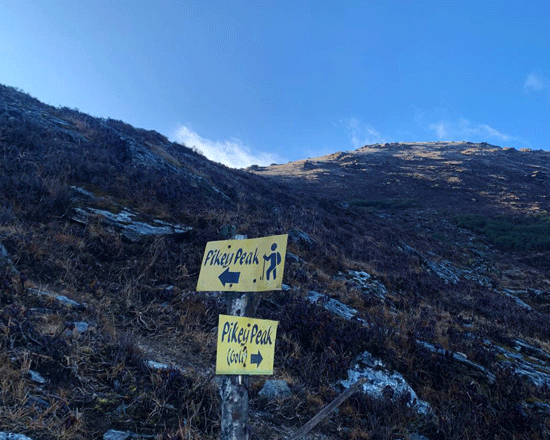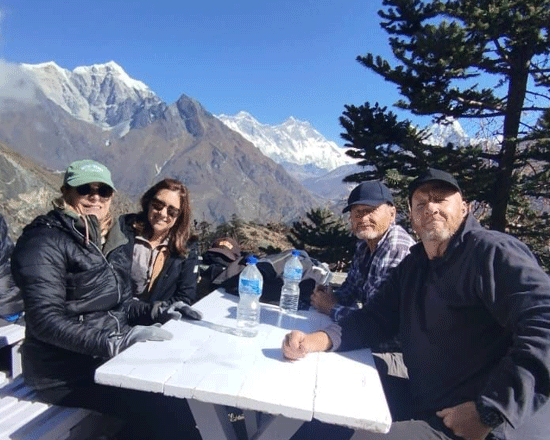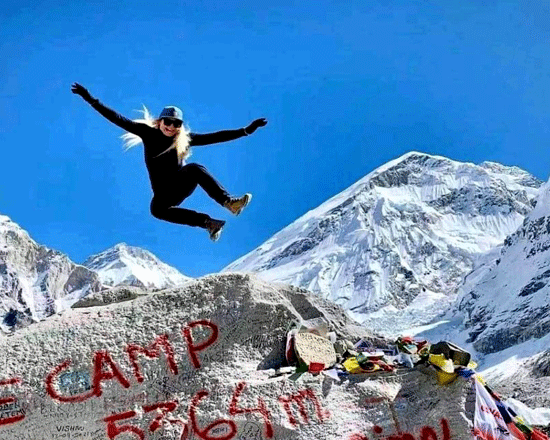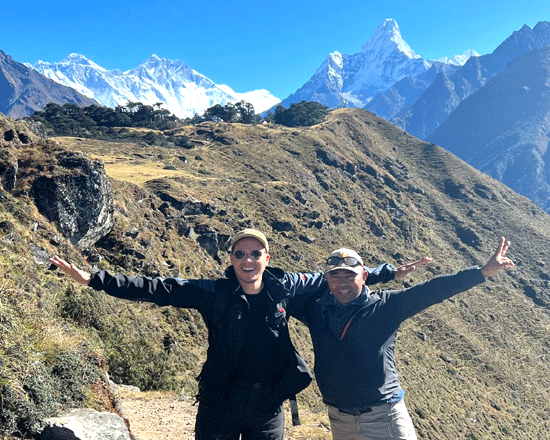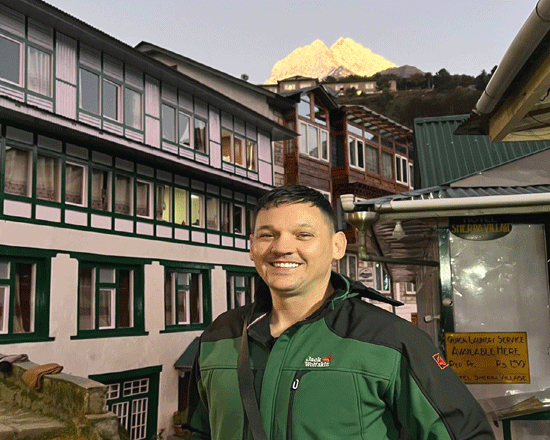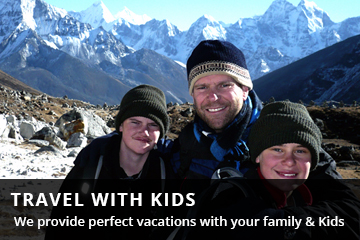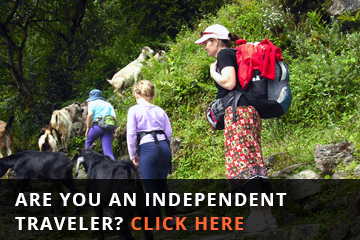Everest Base Camp Trek Without Flight to Lukla
Everest Base Camp Trek Without Flight to Lukla
Everest RegionTrip Facts
Since the terrain can be hard and the days long, hikers on these treks should be in good physical condition and have some previous mountain walking experience. Steep climbing may be involved, although it is never necessary to use ropes. Treks at this level can he arranged for periods of 16 to 21 days. Typically, a gradual ascent through a green river valley will lead you up to a number of high passes, where you will reach the altitude of 5416m. Often times, you will get a close insight into the Tibetan culture. Participants should expect to trek above 5416m/17872ft.
100%
Overview
Everest Base Camp Trek Without Flight to Lukla
Trekkers looking for the Everest Base Camp trek without a flight to Lukla can have access to alternative routes offering unique and rewarding experiences. The EBC trek without a flight to Lukla is the most reliable route to visit the Everest base camp trek. The trekkers follow the footsteps of the renowned mountaineer Sir Edmund Hillary and Tenzing Norgay Sherpa. Many travelers prefer the thrill of flying to Lukla from Kathmandu, the small Himalayan airstrip often regarded as the gateway to the Everest region. However, the higher chances of delay or cancellation of the flight increase the risk of pressure on individuals due to unpredictable weather conditions in the Lukla and Ramechhap. So to reduce the burden of these risks and appreciate the value of time and money adding more scenic views the Nepal Wilderness trekking company has set an alternative route to the Everest trek.
The Benefits of trekking without flight to Lukla
- Trekkers who are under the pressure of flying to Lukla can easily access the roadway without any hassle or worry.
- The Expensive flight to Lukla can be avoided
- The limitation of luggage in the flight which is usually 10-15kg can be extended as needed.
- The risky landing in Lukla due to the short runway can be avoided.
- As the trek starts from a very low elevation trekkers can be well acclimatised.
Why Choose the Overland Route without a flight to Lukla for Ebc?
Flying to Lukla may save time, but it’s also known for unpredictable weather conditions that can delay or cancel flights. For those looking to avoid these risks, trekking to Everest Base Camp without flying presents a fantastic alternative. This route not only bypasses the Lukla flight but also allows you to experience the traditional overland journey, starting from the lowlands and gradually ascending through lush forests and cultural villages. Moreover, by taking this overland journey, you will have more time to acclimatize, which is crucial for preventing altitude sickness.
Thamdanda Paiya: A Scenic Starting Point
One of the best alternative routes to Everest Base Camp without Lukla flight begins at Paiya, a village accessible by road. From here, trekkers can set out on an exhilarating journey through picturesque landscapes and remote villages, culminating at the Everest Base Camp. Ebc trek starting from Paiya is gaining popularity due to the recent expansion of road access. The newly built road network that reaches Paiya provides a convenient way to bypass the Lukla flight entirely.
By starting the trek from Thamdanda Paiya, you’ll walk through serene and less-trodden trails. This is a fantastic opportunity to experience the quiet beauty of the Everest region before joining the more crowded trails closer to Namche Bazaar. The trail from Paiya is both challenging and scenic, offering incredible views of snow-capped mountains and deep gorges.
Road Access to Everest Base Camp Trek: How to Get There
To begin the road access to the Ebc trek, you can now drive from Kathmandu to Thamdanda or Paiya. The drive from Kathmandu usually takes about 9-10 hours, passing through winding mountain roads that offer stunning views of the surrounding countryside. If you prefer a shorter trek, you can take a vehicle to Paiya, which is a day’s walk away from Lukla, further cutting down the trekking time.
The Everest trek by road without a flight to Lukla has several benefits. First, it reduces your dependency on flights that can be delayed or canceled due to bad weather. Second, it allows you to enjoy a road trip through the rugged terrain of Nepal, soaking in the local culture and natural beauty along the way.
Further, some people feel fear of flying to Lukla as being one of the most dangerous airports in the world. If you follow the route of Everest Base Camp Trek by drive you will avoid your mental problem of the Lukla flight.
Trekking from Paiya to Base Camp without a flight to Lukla
After your drive to Paiya, your trekking adventure begins. The Paiya to EBC trek follows a scenic route that passes through remote villages like Surke, and Phakding, eventually connecting to the main trekking trail. From here, you’ll walk the same famous path taken by countless trekkers to reach Everest Base Camp.
The first few days of the trek offer spectacular views of rolling hills, terraced farmland, and dense forests. This part of the journey allows you to gradually acclimate to the increasing altitude, which is crucial for your health as you ascend further into the Himalayas. Along the way, you’ll cross several suspension bridges that span deep river gorges, offering breathtaking views of the valleys below.
Essential Equipment for Ebc Trek without a flight to Lukla
When it comes to equipment, it is crucial to ensure that, you bring the recommended trekking equipment list. Remember, quality trekking equipment can make your trip enjoyable, while a poor one can make it miserable. As the weather can vary depending on the altitude and time of year, suitable footwear includes waterproof walking boots that have been worn before the trek, along with warm socks and gaiters for winter conditions. It is advisable to have loose, casual trousers, and thermal leggings, as well as waterproof pants. Trekkers should ensure they have adequate clothing for varying temperatures, sturdy boots, trekking poles, and a good quality backpack. Trekkers should ensure they have adequate clothing for varying temperatures, sturdy boots, trekking poles, and a good quality backpack.
Physical preparation Level for Ebc trek without a flight to Lukla
- At least 30-45 minutes of running or jogging, 3-5 times a week. Focus on both steady-state runs and interval training to build stamina and endurance.
- Cycling in your routine to build leg strength and cardiovascular fitness. Aim for 60-90 minutes, 2-3 times a week.
- Swimming is a great full-body workout that improves cardiovascular endurance without putting stress on your joints.
- Strength Training in the legs, core, and upper body are the focus areas.
The Main Trekking Route to Everest Base Camp without the flight to Lukla
Once you reach Phakding, you’ll join the classic Ebc trekking trail. From here, the trek follows the Dudh Koshi River towards Namche Bazaar, the bustling Sherpa town that serves as the main hub for trekkers. Namche Bazaar is an excellent place to acclimate before ascending further. The town offers modern amenities, including cafes, bakeries, and gear shops, while also providing insight into the rich Sherpa culture.
After spending a night or two in Namche to adjust to the altitude, you’ll continue your ascent towards Tengboche, home to the famous Tengboche Monastery. This iconic Buddhist monastery sits at 3,860 meters and offers panoramic views of the surrounding peaks, including Ama Dablam, Nuptse, and Everest.
From Tengboche, the trail continues upward, passing through the villages of Dingboche, Lobuche, and finally Gorak Shep, the last stop before reaching Everest Base Camp. The trek to EBC starting from Paiya offers the same awe-inspiring views and sense of accomplishment as the traditional route but with the added benefit of starting from a road-accessible point.
Advantage of Ebc trek without a flight to Lukla
Trekking to Everest Base Camp without flying provides several unique advantages. First, you avoid the stress of potentially canceled or delayed flights, which are common at Lukla due to its high-altitude location and frequent bad weather. Second, the overland journey gives you more time to acclimatize as you slowly ascend into the high Himalayas, reducing the risk of altitude sickness.
The road journey to Thamdanda or Paiya allows you to see more of Nepal’s diverse landscapes, from the subtropical lowlands to the alpine regions. You’ll pass through remote villages where few tourists go, giving you a deeper connection to the local culture and environment.
Acclimatization Days
- As you ascend higher into the Everest region, the air pressure and oxygen levels decrease, leading to lower oxygen saturation in your blood. This can cause altitude-related illnesses such as Acute Mountain Sickness (AMS), High Altitude Pulmonary Edema (HAPE), and High Altitude Cerebral Edema (HACE).
- Acclimatization allows your body time to adjust to the reduced oxygen levels, helping to minimize the risk of these illnesses.
- Acclimatization days provide trekkers and guides to monitor any symptoms of altitude sickness that may develop, such as headache, nausea, dizziness, and fatigue. Additionally, to prevent them from such problems arising which can cause severe conditions.
- Acclimatization improves your physical performance at higher altitudes and reduces the rush and stress of gaining altitude quickly.
Best time for an Ebc trek without a flight to Lukla
For the Ebc trek without a flight to Lukla, the best times to embark on this adventure are during the spring season, specifically from March to June. These months offer trekkers favorable weather conditions and excellent visibility, providing the opportunity to fully immerse themselves in the awe-inspiring natural beauty of the region. With blooming flowers and verdant greenery, the landscape becomes a feast for the senses, enhancing the overall appeal of the trek. Furthermore, during this time, the trails are relatively less crowded compared to the peak trekking season, ensuring a more tranquil and peaceful experience for adventurers.
Alternatively, the early months of September to December also present an optimal window for the Ebc trek without a flight to Lukla. This period marks the autumn season when the weather is stable, and the skies are generally clear. The days offer mild temperatures, perfect for comfortable trekking. Autumn unveils breathtaking views of the surrounding mountains, as the exceptionally clear skies allow trekkers uninterrupted panoramas of the majestic Himalayas. Similar to the spring season, embarking on the Ebc trek without a flight to Lukla during autumn offers the advantage of a peaceful journey, with fewer fellow trekkers on the trails.
Everest Base Camp trek without flight to Lukla: The Final Destination
After days of trekking through breathtaking mountain landscapes, you’ll finally reach Everest Base Camp, situated at an elevation of 5,364 meters. From here, you’ll be able to stand at the foot of the world’s highest peak, marveling at the towering South Face of Everest. The sense of accomplishment that comes with completing this trek, especially via an alternative route, is immense.
On your return journey, you can either retrace your steps back to Paiya or opt to descend to Lukla and catch a flight back to Kathmandu. For those who prefer a round-trip overland journey, it’s possible to trek back down to Paiya and complete your adventure by road, avoiding the flight altogether.
Challenges of Ebc trek without a flight to Lukla
While the Everest Base Camp trek starting from Paiya offers many rewards, it’s important to be aware of the challenges. The road journey to Paiya from Kathmandu can be long and tiring, and the trek itself involves significant elevation gain over several days. Proper acclimatization is key to avoiding altitude sickness. Trekkers need to be well-prepared with proper gear, including sturdy trekking boots, warm clothing, and a good sleeping bag for colder nights at higher elevations.
Since the route from Paiya is less frequented by tourists, it’s advisable to hire a local guide who knows the terrain well. This will not only ensure your safety but also enhance your experience by providing insights into the local culture and history.
Conclusion of Ebc trek without a flight to Lukla
Trekking to Everest Base Camp without a flight to Lukla is a fantastic option for adventurers seeking an alternative route with fewer risks and a more immersive experience. Starting from Thamdanda Paiya provides road access to the trekking trails, offering flexibility and avoiding the unpredictable weather that often disrupts flights to Lukla. Additionally, shorter treks in the lower Khumbu region, such as the Dudh Kunda trek, are also possible by taking a jeep to Phaplu and trekking to Kunda.
The Paiya to Everest Base Camp trek presents trekkers with stunning scenery, cultural encounters, and a gradual ascent that aids in acclimatization. Whether you choose to trek overland to Everest or return by road after reaching base camp, this journey promises an unforgettable adventure in the heart of the Himalayas. Trekkers with limited time frames can choose the short Everest trek. Moreover, we also have organized the shortest trek to Everest the luxury Trek with the helicopter on the way back to Kathmandu. This saves time, thrilling the journey to be near the Everest.
Detail Itinerary
- Day 1: Drive from Kathmandu to Paiya (2,730m) Set off early in the morning for a scenic drive from Kathmandu to Paiya, a journey that takes approximately 18 hours. Enjoy the stunning views of lush countryside, terraced fields, and majestic mountains as you traverse winding roads. Upon arrival, settle into a cozy local lodge and take in the serene surroundings.
- Day 2: Trek from Paiya to Phakding (2,610m) Begin your trek with a descent through verdant forests, passing through charming local villages. Cross several suspension bridges and follow the course of the Dudh Koshi River, immersing yourself in the vibrant culture of the Sherpa people. Arrive in Phakding, where you will spend the night in a comfortable lodge.
- Day 3: Trek from Phakding to Namche Bazaar (3,440m)
Trek through dense forests and cross high suspension bridges, enjoying breathtaking mountain views along the way. As you approach Namche Bazaar, the gateway to Everest, marvel at the vibrant market and rich Sherpa culture. Spend the night in Namche Bazaar, where you can find various lodges and amenities. - Day 4: Acclimatization Day in Namche Bazaar
Take a well-deserved rest day for acclimatization. Explore the bustling streets of Namche Bazaar, visit the local shops, or take a short hike to the Everest View Hotel for panoramic views of Mount Everest and the surrounding peaks. Overnight in Namche Bazaar. - Day 5: Trek from Namche Bazaar to Tengboche (3,860m)
Enjoy a beautiful trek through rhododendron forests, where colorful blooms are in abundance (especially in spring). Visit the Tengboche Monastery, one of the most significant in the region, offering stunning views of Everest and Ama Dablam. Spend the night in Tengboche. - Day 6: Trek from Tengboche to Dingboche (4,410m)
Continue your trek through breathtaking alpine landscapes, keeping Ama Dablam in sight. The trail winds through picturesque valleys and offers glimpses of the local wildlife. Arrive in Dingboche, where you'll spend the night at a comfortable lodge. - Day 7: Acclimatization Day in Dingboche
Use this day to rest and acclimatize. Consider an optional hike to Nagarjun Hill, where you'll be rewarded with spectacular views of the surrounding peaks and valleys. Overnight in Dingboche. - Day 8: Trek from Dingboche to Lobuche (4,940m)
Trek through the Khumbu Valley, passing memorials dedicated to climbers who lost their lives in pursuit of their dreams. Arrive in Lobuche, surrounded by dramatic views of Nuptse and other towering peaks. Overnight in Lobuche. - Day 9: Lobuche to Gorak Shep (5,170m) and Everest Base Camp (5,364m)
Start your day with a trek to Gorak Shep, where you’ll drop your bags before continuing to Everest Base Camp. Experience the thrill of standing at the foot of the world’s highest peak, enjoying breathtaking views of the Khumbu Glacier and surrounding mountains. Return to Gorak Shep for the night. - Day 10: Gorak Shep to Kala Patthar (5,545m) and Descend to Pheriche (4,371m)
Rise early for a hike to Kala Patthar, renowned for its stunning sunrise views over Mount Everest. Capture unforgettable photographs as the sun casts a golden hue on the peak. Afterward, descend to Pheriche, where you’ll spend the night. - Day 11: Pheriche to Namche Bazaar
Retrace your steps back to Namche Bazaar, enjoying the familiar scenery as you descend through the valley. Overnight in Namche Bazaar. - Day 12: Namche Bazaar to Surkey
Continue your descent, passing through well-known villages and absorbing the tranquil atmosphere. Arrive in Surkey and stay overnight in a local lodge. - Day 13: Surkey to Paiya
Complete your trek as you make your way back to Thamdanda. Reflect on your incredible journey through the Khumbu region while enjoying the beautiful landscapes. - Day 14: Drive from Paiya to Kathmandu
Embark on an early morning drive back to Kathmandu, which takes around 10 to 12 hours. Once you arrive, you’ll have the rest of the day to relax or explore the vibrant capital city before your departure.
Cost Included
- Kathmandu to Thamdanda and back sharing Tatasumo Jeep.
- Italian, Chinese, Nepali, Indian, and other European foods are available three times a day (breakfast, lunch, and dinner).
- Accommodation in tea houses according to the itinerary
- Kitbag for storing your belongings
- Sleeping bag for a comfortable night's sleep on a trek in minus-25 degrees
- Everest National Park Entrance Trekking Permit
- Khumbu Pasang Lhamu Rural Municipality Entrance Permit
- Experienced English-speaking, Government licensed holder trekking guide ( 1 porter for every 2 pax)
- Guide, and Porter meals, accommodation, salary, and insurance
- Necessary paper works, all government, and local taxes
- A certificate of appreciation from Nepal wilderness trekking after a successful trek
Cost Excluded
- Airfare for international flights
- Upon arrival at Tribhuwan International Airport, Nepal entry visa fees vary by duration (15 days - $25-30, 30 days
- Accommodations and meals in Kathmandu before and after our journey
- Personal equipment for high and cold temperatures
- Emergency high-altitude rescue and evacuation are covered by travel insurance
- All beverages, Soft and caffeinated table drinks such as coke, beer,
- Drinking water/mineral water, Dessert, etc. Hot shower, laundry
- Tip for guide and porter
- Excluded are all costs and expenses not listed under "cost includes"
- Inclusion of costs or delays beyond the control of the management, such as landslides, weather conditions, itinerary modifications due to safety concerns, illness, changes in government policies, strikes, etc.
| Trip Dates | Trip Price | Confirmed Pax | Trip Status | |
|---|---|---|---|---|
| April 16, 2025 | US$ 1200 | Join a Group | Book Now | |
| April 19, 2025 | US$ 1200 | Join a Group | Book Now | |
| April 22, 2025 | US$ 1200 | Join a Group | Book Now | |
| April 25, 2025 | US$ 1200 | Join a Group | Book Now | |
| April 30, 2025 | US$ 1200 | Join a Group | Book Now | |
| May 8, 2025 | US$ 1200 | Join a Group | Book Now | |
| May 12, 2025 | US$ 1200 | Join a Group | Book Now | |
| May 16, 2025 | US$ 1200 | Join a Group | Book Now | |
| May 18, 2025 | US$ 1200 | Join a Group | Book Now | |
| May 23, 2025 | US$ 1200 | Join a Group | Book Now | |
| May 27, 2025 | US$ 1200 | Join a Group | Book Now | |
| May 30, 2025 | US$ 1200 | Join a Group | Book Now | |
| June 3, 2025 | US$ 1200 | Join a Group | Book Now | |
| June 9, 2025 | US$ 1200 | Join a Group | Book Now | |
| June 13, 2025 | US$ 1200 | Join a Group | Book Now | |
| June 17, 2025 | US$ 1200 | Join a Group | Book Now | |
| June 22, 2025 | US$ 1200 | Join a Group | Book Now | |
| June 26, 2025 | US$ 1200 | Join a Group | Book Now | |
| June 30, 2025 | US$ 1200 | Join a Group | Book Now | |
| July 3, 2025 | US$ 1200 | Join a Group | Book Now | |
| July 10, 2025 | US$ 1200 | Join a Group | Book Now | |
| July 18, 2025 | US$ 1200 | Join a Group | Book Now | |
| July 24, 2025 | US$ 1200 | Join a Group | Book Now | |
| July 30, 2025 | US$ 1200 | Join a Group | Book Now | |
| August 3, 2025 | US$ 1200 | Join a Group | Book Now | |
| August 10, 2025 | US$ 1200 | Join a Group | Book Now | |
| August 15, 2025 | US$ 1200 | Join a Group | Book Now | |
| August 20, 2025 | US$ 1200 | Join a Group | Book Now | |
| August 30, 2025 | US$ 1200 | Join a Group | Book Now | |
| September 3, 2025 | US$ 1200 | Join a Group | Book Now | |
| September 8, 2025 | US$ 1200 | Join a Group | Book Now | |
| September 13, 2025 | US$ 1200 | Join a Group | Book Now | |
| September 17, 2025 | US$ 1200 | Join a Group | Book Now | |
| September 20, 2025 | US$ 1200 | Join a Group | Book Now | |
| September 24, 2025 | US$ 1200 | Join a Group | Book Now | |
| September 26, 2025 | US$ 1200 | Join a Group | Book Now | |
| September 30, 2025 | US$ 1200 | Join a Group | Book Now | |
| October 3, 2025 | US$ 1200 | Join a Group | Book Now | |
| October 9, 2025 | US$ 1200 | Join a Group | Book Now | |
| October 12, 2025 | US$ 1200 | Join a Group | Book Now | |
| October 16, 2025 | US$ 1200 | Join a Group | Book Now | |
| October 22, 2025 | US$ 1200 | Join a Group | Book Now | |
| October 26, 2025 | US$ 1200 | Join a Group | Book Now | |
| October 28, 2025 | US$ 1200 | Join a Group | Book Now | |
| October 31, 2025 | US$ 1200 | 1200 | Join a Group | Book Now |
| November 5, 2025 | US$ 1200 | Join a Group | Book Now | |
| November 8, 2025 | US$ 1200 | Join a Group | Book Now | |
| November 12, 2025 | US$ 1200 | Join a Group | Book Now | |
| November 16, 2025 | US$ 1200 | Join a Group | Book Now | |
| November 22, 2025 | US$ 1200 | Join a Group | Book Now | |
| November 25, 2025 | US$ 1200 | Join a Group | Book Now | |
| November 27, 2025 | US$ 1200 | Join a Group | Book Now | |
| November 30, 2025 | US$ 1200 | Join a Group | Book Now | |
| December 3, 2025 | US$ 1200 | Join a Group | Book Now | |
| December 7, 2025 | US$ 1200 | Join a Group | Book Now | |
| December 10, 2025 | US$ 1200 | Join a Group | Book Now | |
| December 15, 2025 | US$ 1200 | Join a Group | Book Now | |
| December 20, 2025 | US$ 1200 | Join a Group | Book Now | |
| December 26, 2025 | US$ 1200 | Join a Group | Book Now | |
| December 30, 2025 | US$ 1200 | Join a Group | Book Now | |
| January 2, 2026 | US$ 1200 | Join a Group | Book Now | |
| January 8, 2026 | US$ 1200 | Join a Group | Book Now | |
| January 12, 2026 | US$ 1200 | Join a Group | Book Now | |
| January 15, 2026 | US$ 1200 | Join a Group | Book Now | |
| January 20, 2026 | US$ 1200 | Join a Group | Book Now | |
| January 24, 2026 | US$ 1200 | Join a Group | Book Now | |
| January 30, 2026 | US$ 1200 | Join a Group | Book Now | |
| February 2, 2026 | US$ 1200 | Join a Group | Book Now | |
| February 8, 2026 | US$ 1200 | Join a Group | Book Now | |
| February 12, 2026 | US$ 1200 | Join a Group | Book Now | |
| February 16, 2026 | US$ 1200 | Join a Group | Book Now | |
| February 20, 2026 | US$ 1200 | Join a Group | Book Now | |
| February 26, 2026 | US$ 1200 | Join a Group | Book Now | |
| March 2, 2026 | US$ 1200 | Join a Group | Book Now | |
| March 6, 2026 | US$ 1200 | Join a Group | Book Now | |
| March 10, 2026 | US$ 1200 | Join a Group | Book Now | |
| March 14, 2026 | US$ 1200 | Join a Group | Book Now | |
| March 18, 2026 | US$ 1200 | Join a Group | Book Now | |
| March 22, 2026 | US$ 1200 | Join a Group | Book Now | |
| March 26, 2026 | US$ 1200 | Join a Group | Book Now | |
| March 31, 2026 | US$ 1200 | Join a Group | Book Now | |
| April 3, 2026 | US$ 1200 | Join a Group | Book Now | |
| April 7, 2026 | US$ 1200 | Join a Group | Book Now | |
| April 12, 2026 | US$ 1200 | Join a Group | Book Now | |
| April 15, 2026 | US$ 1200 | Join a Group | Book Now | |
| April 20, 2026 | US$ 1200 | Join a Group | Book Now | |
| April 24, 2026 | US$ 1200 | Join a Group | Book Now | |
| April 28, 2026 | US$ 1200 | Join a Group | Book Now | |
| April 30, 2026 | US$ 1200 | Join a Group | Book Now | |
| May 2, 2026 | US$ 1200 | Join a Group | Book Now | |
| May 6, 2026 | US$ 1200 | Join a Group | Book Now | |
| May 10, 2026 | US$ 1200 | Join a Group | Book Now | |
| May 15, 2026 | US$ 1200 | Join a Group | Book Now | |
| May 20, 2026 | US$ 1200 | Join a Group | Book Now | |
| May 24, 2026 | US$ 1200 | Join a Group | Book Now | |
| May 28, 2026 | US$ 1200 | Join a Group | Book Now | |
| May 31, 2026 | US$ 1200 | Join a Group | Book Now | |
| June 4, 2026 | US$ 1200 | Join a Group | Book Now | |
| June 8, 2026 | US$ 1200 | Join a Group | Book Now | |
| June 12, 2026 | US$ 1200 | Join a Group | Book Now | |
| June 16, 2026 | US$ 1200 | Join a Group | Book Now | |
| June 20, 2026 | US$ 1200 | Join a Group | Book Now | |
| June 25, 2026 | US$ 1200 | Join a Group | Book Now | |
| June 30, 2026 | US$ 1200 | Join a Group | Book Now | |
| July 2, 2026 | US$ 1200 | Join a Group | Book Now | |
| July 6, 2026 | US$ 1200 | Join a Group | Book Now | |
| July 10, 2026 | US$ 1200 | Join a Group | Book Now | |
| July 15, 2026 | US$ 1200 | Join a Group | Book Now | |
| July 20, 2026 | US$ 1200 | Join a Group | Book Now | |
| July 24, 2026 | US$ 1200 | Join a Group | Book Now | |
| July 28, 2026 | US$ 1200 | Join a Group | Book Now | |
| July 31, 2026 | US$ 1200 | Join a Group | Book Now | |
| August 2, 2026 | US$ 1200 | Join a Group | Book Now | |
| August 6, 2026 | US$ 1200 | Join a Group | Book Now | |
| August 10, 2026 | US$ 1200 | Join a Group | Book Now | |
| August 14, 2026 | US$ 1200 | Join a Group | Book Now | |
| August 18, 2026 | US$ 1200 | Join a Group | Book Now | |
| August 22, 2026 | US$ 1200 | Join a Group | Book Now | |
| August 26, 2026 | US$ 1200 | Join a Group | Book Now | |
| August 30, 2026 | US$ 1200 | Join a Group | Book Now | |
| August 2, 2026 | US$ 1200 | Join a Group | Book Now | |
| August 4, 2026 | US$ 1200 | Join a Group | Book Now | |
| August 8, 2026 | US$ 1200 | Join a Group | Book Now | |
| August 12, 2026 | US$ 1200 | Join a Group | Book Now | |
| August 16, 2026 | US$ 1200 | Join a Group | Book Now | |
| August 20, 2026 | US$ 1200 | Join a Group | Book Now | |
| August 24, 2026 | US$ 1200 | Join a Group | Book Now | |
| August 28, 2026 | US$ 1200 | Join a Group | Book Now | |
| August 31, 2026 | US$ 1200 | Join a Group | Book Now | |
| September 2, 2026 | US$ 1200 | Join a Group | Book Now | |
| September 7, 2026 | US$ 1200 | Join a Group | Book Now | |
| September 11, 2026 | US$ 1200 | Join a Group | Book Now | |
| September 15, 2026 | US$ 1200 | Join a Group | Book Now | |
| September 20, 2026 | US$ 1200 | Join a Group | Book Now | |
| September 24, 2026 | US$ 1200 | Join a Group | Book Now | |
| September 28, 2026 | US$ 1200 | Join a Group | Book Now | |
| September 28, 2026 | US$ 1200 | Join a Group | Book Now | |
| September 30, 2026 | US$ 1200 | Join a Group | Book Now | |
| October 2, 2026 | US$ 1200 | Join a Group | Book Now | |
| October 6, 2026 | US$ 1200 | Join a Group | Book Now | |
| October 12, 2026 | US$ 1200 | Join a Group | Book Now | |
| October 16, 2026 | US$ 1200 | Join a Group | Book Now | |
| October 18, 2026 | US$ 1200 | Join a Group | Book Now | |
| October 22, 2026 | US$ 1200 | Join a Group | Book Now | |
| October 26, 2026 | US$ 1200 | Join a Group | Book Now | |
| October 30, 2026 | US$ 1200 | Join a Group | Book Now | |
| November 2, 2026 | US$ 1200 | Join a Group | Book Now | |
| November 6, 2026 | US$ 1200 | Join a Group | Book Now | |
| November 12, 2026 | US$ 1200 | Join a Group | Book Now | |
| November 16, 2026 | US$ 1200 | Join a Group | Book Now | |
| November 20, 2026 | US$ 1200 | Join a Group | Book Now | |
| November 25, 2026 | US$ 1200 | Join a Group | Book Now | |
| November 30, 2026 | US$ 1200 | Join a Group | Book Now | |
| December 2, 2026 | US$ 1200 | Join a Group | Book Now | |
| December 6, 2026 | US$ 1200 | Join a Group | Book Now | |
| December 10, 2026 | US$ 1200 | Join a Group | Book Now | |
| November 15, 2026 | US$ 1200 | Join a Group | Book Now | |
| December 20, 2026 | US$ 1200 | Join a Group | Book Now | |
| December 25, 2026 | US$ 1200 | Join a Group | Book Now | |
| December 30, 2026 | US$ 1200 | Join a Group | Book Now |

